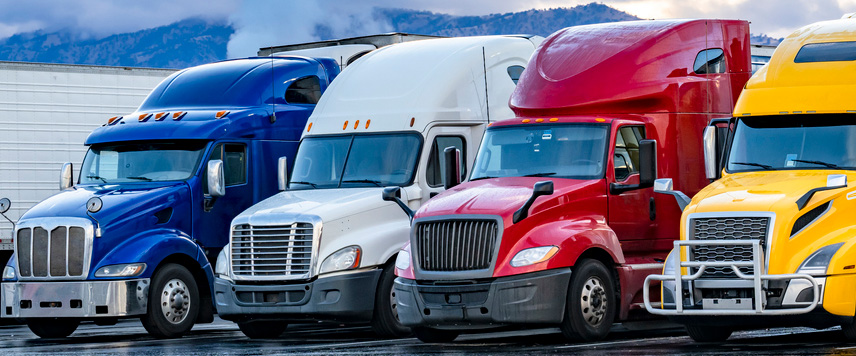Many experts are predicting a rebound in the freight market in 2024! While that is good news for everyone in the trucking industry, many are still concerned about the effects that autonomous trucks will have on all the facets of this line of work. Over the past few years, more and more news stories have been devoted to cars with automated driving technology, but now it is time to hear about the semi-trucks testing these same systems.
Fully automated trucks are still years away from being at their peak functionality. To get there, though, testing is being done on stretches of interstate by companies across the United States and Europe. Developers and engineers at places like Aurora Innovation and Kodiak Robotics and Waymo, just a few of the heavy hitting names in this area, have already partnered with trucking companies to test their autonomous truck systems, with more being launched in the coming months. These tests are being monitored and commented on by nearly everyone with a stake in the industry. Truck drivers, themselves, along with the Teamsters, and other labor union representatives are concerned about this new technology pushing drivers out of their jobs. Politicians and law enforcement are concerned about the response time of the automated trucks on the road with other non-commercial vehicles. Drivers of passenger cars are worried about that as well, and, with over 5,000 deaths on the road attributed to large trucks, they have a right to be concerned about what happens in trucks without a driver in them.
The road to autonomous trucking has been a long one, and there are miles to go yet. However, it is important to know where this technology is now and where it is going to be in 2024 and beyond.
“Yeah, we got a little ol’ convoy…”
What kind of automated trucks can we expect to see on the road this year? As stated above, there are several out there already being tested! When it comes to automated trucking, there are two prongs to the approach. The first forays into this autonomous industry includes installing automated driving software into currently running trucks. In this area, companies like Aurora Innovation and Kodiak Robotics are attempting to set the standard. In the fourth quarter of 2023, Aurora opened new lanes for driverless trucks on the interstates between Dallas and Houston and Fort Worth and El Paso. Teamed up with FedEx, Aurora has their software driving trucks back and forth between these four major cities. All in Texas, with their large number of long stretches of open road, the Lone Star State has become popular as a place to test out this automated driving technology.
Aurora Innovation’s self-driving software is one of the more popular forms of automated driving because it can be added to existing trucks. Aurora has partnered with companies like Toyota, PACCAR, and Volvo to put their technology into trucks for testing on the road. So far, all of the trucks with the self-driving software in it also have a driver there to take over in case of an emergency. Companies, like Kodiak Robotics, have also partnered with FedEx, introducing a system that is being tested with the team of safety and technology experts being rotated through the cab on a long drive.
The second prong involves brand new trucks. Companies like International have put out the International LT, and they are focusing on a total design that includes all kinds of high tech gadgets to make long-haul driving easier. While not considered fully autonomous, this truck comes standard with a Bendix Wingman Fusion Collision Mitigation System: a system that uses automated, or “intuitive,” controls to enhance visibility, keep the cab quiet and distraction-free, and provides up-to-date traffic and weather news. With a predictive cruise control, it also adapts its speed for safety and fuel efficiency. The International is just one of the companies building trucks for the future. Tesla, Kenworth, Volvo, and others are jumping onboard as well. Each wants their trucks to be the fastest and safest on the road, and each one is making room for automated technology to be a part of their truck’s amenity package.
Where can you expect these automated trucks to run first? Yes, some of them have been launched in Texas, but others can be found out west in California, even if there is a battle brewing over how long they will have human drivers in them. (More on that below!) As stated above, there is even a FedEx route from Dallas to Atlanta that is being run by automated trucks today. Many of the companies leading the way with the automated driving technology hope that passing motorists have no idea how these trucks are being moved forward. They hope that by the time the public realizes they are even out there, the technology will have rolled out in more trucks. If the data shows that these trucks are safer, then the goal is to show passenger vehicles the results already combed through.
So far, these experts have been tracked taking over the wheel several times on these treks, meaning they do not feel comfortable with the fully autonomous system, yet. While plans are in motion to get the human drivers out of the trucks before summer of 2024, there are so many variables up in the air at this time that experts are waiting to see what will happen next.
“East bound and down, loaded up and truckin’…”
Some of these variables include laws and legislation being created to mitigate the effects of these trucks with autonomous driving systems. Many people who regularly traverse the country on the interstates are concerned about whether these trucks are safe enough, or whether they will wreak havoc on the roads. On the flip side of that worry, people realize that trucking is an extremely difficult job, and drivers are constantly battling boredom and fatigue, among a plethora of other medical and mental health issues, on the road. While automated trucks will be able to curtail those issues, they have not, as of yet, been able to calm the fears of the drivers of passenger vehicles alongside them.
Some others, particularly the Teamsters Union, worry about truck drivers still being able to work after the autonomous rollouts. They believe and promote the idea that automated truck software will force trucker drivers out of their current jobs, and very soon, without giving them a chance to find other jobs. For many who participate in or work with the labor unions, they feel as if the companies leading the automated trucking charge are not answering drivers’ questions. While companies like Aurora claim to be working with those in the industry, some truckers are concerned that they have not been able to voice their worries and believe that they will be left out in the cold as automated trucks become more prevalent.
In order to alleviate pressures from both motorists and unions, the state of California, as recently as summer 2023, passed a law called AB 316. Spearheaded by labor unions and their many allies, AB 316’s goal is to keep a driver in the truck, even when the software allows for safe autonomous trucking. Supposedly, this will keep truckers employed and passenger cars safer on the highways and interstates of the state. It will also create an environment where trucking companies, who are trying to save time and money by not having a driver in the truck, will lose many of the potential benefits that removing the driver will make. The governor of California, Gavin Newsome, vetoed the bill shortly after its passing, citing concern it would stifle future innovations. All of us in the trucking industry will be watching and participating in this debate for years to come.
Conclusion
Automated trucking is coming to the United States, whether the general public is ready for it or not. While the timing will vary depending on the company, some are hoping to go without their emergency human driver by the end of spring 2024. These trucks are being tested out on the roads right now, and even though no test is without its hiccups, the latest and greatest software will be driving 18-wheelers down American interstates before we know it. The companies putting the software into semi-trucks have spent years and millions of dollars trying to get people outside of the trucking industry to be ready for this move. Unfortunately, these overtures have caused more concerns than comforts, and not every company and worker has embraced the coming changes. Since companies like Aurora and Kodiak have seemingly left the truck drivers of the industry out in the dark, most everyone seems nervous about the pending adaptations and conversions, particularly those who depend on driving to make a living. Stay tuned to the LZBlog as we will work to stay apprised on the issue!
__________________________________________________________________________
Meaghan Goldberg covers recruitment and digital marketing for Lionzone. A Patterson, GA native, after graduating from both Valdosta State University and Middle Tennessee State University, Meaghan joined Lionzone in 2018 as a digital recruitment strategist before becoming the social media manager.
Resources:
https://www.barrons.com/articles/aurora-self-driving-cars-trucks-ces-51672953849
https://www.linkedin.com/pulse/class-8-trucks-2024-leading-charge-efficiency/
https://www.theverge.com/23981006/autonomous-truck-semi-driverless-aurora-kodiak-infrastructure
https://www.nytimes.com/2022/09/28/business/driverless-trucks-highways.html
https://www.ttnews.com/articles/autonomous-trucks-reshaping-freight-industry




